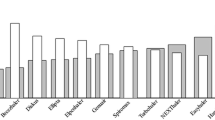Abstract
The prevalence of chronic obstructive pulmonary disease (COPD) increases with age. Elderly patients pose unique challenges with regard to the use of devices to deliver inhaled bronchodilators and corticosteroids, the key pharmacological treatments for COPD. The management of COPD in elderly patients, therefore, should involve individualized treatment plans that take into account the patient- and device-related factors. Healthcare professionals must provide adequate training on different inhaler device techniques, with regular reassessment and, when necessary, retraining.

Similar content being viewed by others
References
Global strategy for the diagnosis, management, and prevention of chronic obstructive pulmonary disease: 2016. Bethesda: Global Initiative for Chronic Obstructive Lung Disease (GOLD); 2015.
Lavorini F, Mannini C, Chellini E, et al. Optimising inhaled pharmacotherapy for elderly patients with chronic obstructive pulmonary disease: the importance of delivery devices. Drugs Aging. 2016;33(7):461–73.
Janssens JP. Aging of the respiratory system: impact on pulmonary function tests and adaptation to exertion. Clin Chest Med. 2005;26(3):469–72.
Thomas M, Price D, Chrystyn H, et al. Inhaled corticosteroids for asthma: impact of practice level device switching on asthma control. BMC Pulm Med. 2009;9:1.
Dekhuijzen PN, Vincken W, Virchow JC, et al. Prescription of inhalers in asthma and COPD: towards a rational, rapid and effective approach. Respir Med. 2013;107(12):1817–21.
Barrons R, Pegram A, Borries A. Inhaler device selection: special considerations in elderly patients with chronic obstructive pulmonary disease. Am J Heal Pharm. 2011;68(13):1221–32.
Göriş S, Taşci S, Elmali F. The effects of training on inhaler technique and quality of life in patients with COPD. J Aerosol Med Pulm Drug Deliv. 2013;26(6):336–44.
Fink JB, Rubin BK. Problems with inhaler use: a call for improved clinician and patient education. Respir Care. 2005;50(10):1360–74.
Jolly GP, Mohan A, Guleria R, et al. Evaluation of metered dose inhaler use technique and response to educational training. Indian J Chest Dis Allied Sci. 2015;57(1):17–20.
Ho SF, OMahony MS, Steward JA, et al. Inhaler technique in older people in the community. Age Ageing. 2004;33(2):185–8.
Laube BL, Janssens HM, de Jongh FHC, et al. European Respiratory Society; International Society for Aerosols in Medicine. What the pulmonary specialist should know about the new inhalation therapies. Eur Respir J. 2011;37(6):1308–31.
Acerbi D, Brambilla G, Kottakis I. Advances in asthma and COPD management: delivering CFC-free inhaled therapy using Modulite technology. Pulm Pharmacol Ther. 2007;20(3):290–303.
Dhillon S, Keating GM. Beclometasone dipropionate/formoterol: in an HFA-propelled pressurised metered-dose inhaler. Drugs. 2006;66(11):1475–83.
Lavorini F, Fontana GA. Targeting drugs to the lungs: effect of spacer device. Exp Opin Drug Deliv. 2009;6(1):91–102.
Lenny J, Innes J, Crompton GK. Inappropriate inhaler use: assessment of use and patient preference of seven inhalation devices. Respir Med. 2000;94:496–500.
Molimard M, Raherison C, Lignot S, et al. Assessment of handling of inhaler devices in real life: an observational study in 3811 patients in primary care. J Aerosol Med. 2003;16(3):249–54.
Azouz W, Chrystyn H. Clarifying the dilemmas about inhalation techniques for dry powder inhalers: integrating science with clinical practice. Prim Care Respir J. 2012;21(2):208–13.
Chrystyn H, Small M, Milligan G, et al. Impact of patients’ satisfaction with their inhalers on treatment compliance and health status in COPD. Respir Med. 2014;108(2):358–65.
Newman S. Improving inhaler technique, adherence to therapy and the precision of dosing: major challenges for pulmonary drug delivery. Expert Opin Drug Deliv. 2014;11(3):365–78.
Dalby R, Spallek M, Voshaar T. A review of the development of Respimat soft mist inhaler. Int J Pharm. 2004;283(1–2):1–9.
Denyer J. Adaptive aerosol delivery in practice. Eur Respir Rev. 1997;7(6):388–9.
Dhand R. Nebulisers that use a vibrating mesh or plate with multiple apertures to generate aerosol. Respir Care. 2002;47(12):1406–16.
Waldrep JC, Dhand R. Advanced nebulizer designs employing vibrating mesh/aperture plate technologies for aerosol generation. Curr Drug Deliv. 2008;5(2):114–9.
Author information
Authors and Affiliations
Consortia
Ethics declarations
The article was adapted from Drugs and Aging 2016;33(7):461–73 [2] by salaried employees of Adis/Springer and was not supported by any external funding.
Rights and permissions
About this article
Cite this article
Adis Medical Writers. Selecting the best device to deliver inhaled chronic obstructive pulmonary disease therapy in elderly patients requires an individualized approach. Drugs Ther Perspect 33, 119–123 (2017). https://doi.org/10.1007/s40267-017-0379-9
Published:
Issue Date:
DOI: https://doi.org/10.1007/s40267-017-0379-9



